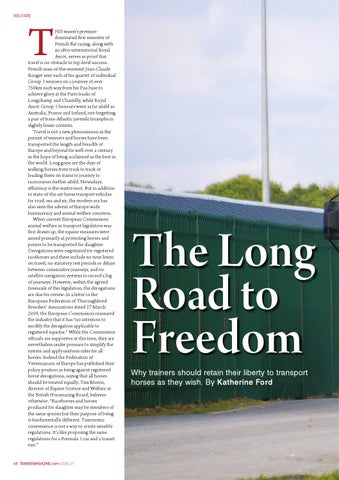TRANSPORT ISSUE 27.qxd:Jerkins feature.qxd
21/8/09
12:34
Page 1
WELFARE
T
HIS season’s provincedominated first semester of French flat racing, along with an ultra-international Royal Ascot, serves as proof that travel is no obstacle to top-level success. French man-of-the-moment Jean-Claude Rouget sent each of his quartet of individual Group 1 winners on a journey of over 750km each way from his Pau base to achieve glory at the Paris tracks of Longchamp and Chantilly, while Royal Ascot Group 1 honours went as far afield as Australia, France and Ireland, not forgetting a pair of trans-Atlantic juvenile triumphs in slightly lesser contests. Travel is not a new phenomenon in the pursuit of winners and horses have been transported the length and breadth of Europe and beyond for well over a century in the hope of being acclaimed as the best in the world. Long gone are the days of walking horses from track to track or loading them on trains to journey to racecourses further afield. Nowadays, efficiency is the maitre-mot. But in addition to state-of-the-art horse transport vehicles for road, sea and air, the modern era has also seen the advent of Europe-wide bureaucracy and animal welfare concerns. When current European Commission animal welfare in transport legislation was first drawn up, the equine measures were aimed primarily at protecting horses and ponies to be transported for slaughter. Derogations were negotiated for registered racehorses and these include no time limits on travel, no statutory rest periods or delays between consecutive journeys, and no satellite navigation systems to record a log of journeys. However, within the agreed timescale of this legislation, the derogations are due for review. In a letter to the European Federation of Thoroughbred Breeders’ Associations dated 27 March 2009, the European Commission reassured the industry that it has “no intention to modify the derogation applicable to registered equidae.” While the Commission officials are supportive at this time, they are nevertheless under pressure to simplify the system and apply uniform rules for all horses. Indeed the Federation of Veterinarians of Europe has published their policy position as being against registered horse derogations, saying that all horses should be treated equally. Tim Morris, director of Equine Science and Welfare at the British Horseracing Board, believes otherwise. “Racehorses and horses produced for slaughter may be members of the same species but their purpose of being is fundamentally different. Taxonomic convenience is not a way to create sensible regulations. It’s like proposing the same regulations for a Formula 1 car and a transit van.”
68 TRAINERMAGAZINE.com ISSUE 27
The Long Road to Freedom
Why trainers should retain their liberty to transport horses as they wish. By Katherine Ford
